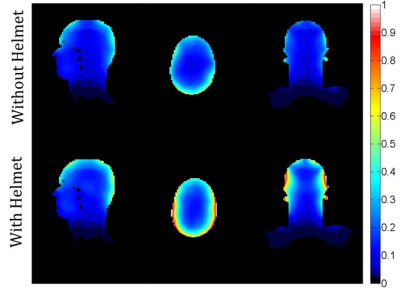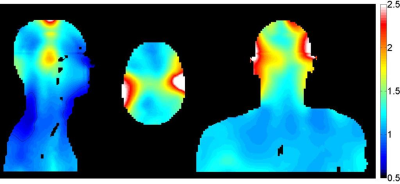4405
SNR Evaluation for a high-permittivity dielectric helmet-shaped coil former for a 28 channel receive array1Radiology, Center for Advanced Imaging Innovation and Research (CAI2R), New York, NY, United States, 2Radiology, Bernard and Irene Schwartz Center for Biomedical Imaging, New York, NY, United States, 3Radiology, Pennsylvania State University College of Medicine, Hershey, PA, United States
Synopsis
The performance of a high-permittivity helmet-shaped former is evaluated when used to improve the SNR in the head for a 28-channel receive array coil. Through simulations, it was found that the use of the helmet can dramatically increase the SNR in the head, up to more than 3 times the original value in some locations of the head, and about 50% increase overall in the brain.
Purpose
To estimate the potential SNR improvement provided by a high-permittivity dielectric material helmet-shaped coil former.Introduction
High permittivity materials (HPMs), formed into pads and placed between commercial RF coils and a subject, have been widely shown to improve local SNR in both simulations and experiments. Integrating fixed HPMs into custom RF coils is a novel way to maximize this contribution to the RF signal throughout the imaging region. A fixed dielectric helmet positioned inside a large volume transmit coil at 7T was shown to increase transmit efficiency and homogeneity, and reduce SAR in simulation1. A similar dielectric helmet was shown to significantly improve SNR for an 8 channel tight-fitting receive array coil2. However, interactions between the RF coil and the high permittivity material become a limiting factor for HPM use with resonant RF coils of this size3, suggesting a more densely packed receive array with smaller coils may benefit more from HPM integration. In this work, we evaluate the SNR performance of a dielectric helmet when used with a 28-element receive array in simulation as a first step in the construction of an RF coil built around an integrated HPM former.Methods
An 8mm
thick HPM helmet was designed (Fig .1), with relative permittivity $$$\epsilon_R=115$$$. The HPM helmet was simulated around the head
of the Virtual Family “Duke” model (5mm resolution) using the commercial software Microwave Studio (CST
2017, Darmstadt, Germany). A
28-loop receive array was positioned around the helmet (Fig. 1), and centered
within a cylindrical gradient shield (35cm radius, 1m length). Each
loop was tuned and matched in isolation to the operating frequency at 7T
(300MHz), and simulations were performed with an adaptive mesh resolution to
improve model accuracy proximal to the coil. SNR was computed under the
assumption of a uniform transmit field throughout the Field of View, and the
fields were exported on a uniform Cartesian grid with 2.5mm resolution in each
direction. The SNR was computed with the equation
$$SNR=\sqrt{\Psi^{'*}R^{-1}\Psi}$$
where is the sensitivity matrix and R the covariance matrix4. These calculations were repeated with the relative permittivity of the helmet set to 1, to analyze the effect of the HPM former on the RF coil.
Results
All receive coils were able to be cleanly tuned and matched in the presence of the HPM. The SNR distribution along three orthogonal planes is plotted in Fig. 2 both in the presence (with helmet) and absence (without helmet) of the HPM. The SNR improvement provided by the HPM former is visualized in Fig. 3 by viewing the SNR ratio ($$$SNR_{HPM}/SNR_{Air}$$$) in three orthogonal planes. Contour lines denote where the SNR is the same with and without the HPM helmet, or where the SNR ratio is 1. A significant overall SNR improvement is observed, with a maximum gain of 220%, in a location on the side of the head. In the brain, the average improvement is 51%. No SNR loss was observed in the brain in the presence of the HPM, though some SNR reduction was found in the nose and in the neck.Conclusion
The results obtained in simulations are very promising, and show that the use of an HPM helmet can significantly improve the overall SNR of a tight-fitting receive array. Limiting the SNR analysis by removing coil coupling effects provided simulation efficiency and removed variations in SNR from geometrical changes that may have been required by decoupling optimization. Simulations suggest that the presence of HPMs may improve coil coupling4, and the authors expect coupling effects to not dramatically change these results. Different geometries for the HPM helmet were evaluated in the design process, including solutions with holes near the eyes and different permittivity values. Although higher permittivity values provide higher SNR gain in the periphery of the brain, SNR loss in the center of the brain5 and split resonance effects6 were observed for very high values of permittivity. Though future investigations may provide designs that maximize SNR even further, this HPM helmet design appears to be a good match for a 28-channel receive array, and these simulations provide enough confirmation to move forward with the construction process.Acknowledgements
Funding for this work from the through the Center for Advanced Imaging Innovation and Research (CAI2R), an NIH-funded research center (R01 EB017183), and through R01 NIBIB 021277.References
1. Collins CM, Yang QX. Potential for a Single High-Dielectric Head Coil Former to Reduce SAR and Improve SNR in Brain for a Wide Variety of Coils at 7T. In Proceedings of the 21st Annual Meeting of ISMRM, Salt Lake City, UT, USA, 2013, p. 2797.
2. Collins CM, Carluccio G, Vaidya MV, Haemer GG, Luo W,
Lattanzi R, Wiggins GC, Sodickson DK, Yang QX. High-Permittivity Materials Can
Improve Global Performance and Safety of Close-Fitting Arrays. In Proceedings of the 22nd Annual Meeting of ISMRM, Milan,
Italy, 2014, p. 404.
2. Haemer G, Vaidya M, Collins CM, Sodickson DK, Wiggins G. Evaluation of a High Permittivity Helmet for Use as a Coil Former for an 8ch Transmit/receive Array with Dodecahedral Symmetry. In Proceedings of the 25th Annual Meeting of ISMRM, Honolulu, HI, USA, 2017, p. 4283.
3. Roemer PB, Edelstein WA, Hayes CE, Souza SP, Mueller OM. The NMR phased array. Magnetic resonance in medicine. 1990 Nov 1;16(2):192-225.
4. Haemer GG, Vaidya MV, Collins CM, Wiggins GC. Changes in Neighbor and Next-Nearest-Neighbor Coupling of
Transmit/receive Arrays in the Presence of Close-Fitting High
Permittivity Materials. In Proceedings of the 23rd Annual Meeting of ISMRM, Toronto,
Canada, 2015, p. 3104.
5. Teeuwisse WM, Brink WM, Haines KN, Webb AG. Simulations of high permittivity materials for 7 T neuroimaging and evaluation of a new barium titanate‐based dielectric. Magnetic resonance in medicine. 2012 Apr 1;67(4):912-8.
6. Haemer G, Collins CM, Sodickson DK, Wiggins G. Discovering and working around effects of unwanted resonant modes in high permittivity materials placed near RF coils. In Proceedings of the 23rd Annual Meeting of ISMRM, Toronto, ON, Canada, 2015, p. 859.
Figures


